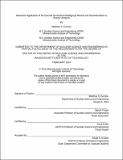| dc.contributor.advisor | Benoit Forget. | en_US |
| dc.contributor.author | Everson, Matthew S | en_US |
| dc.contributor.other | Massachusetts Institute of Technology. Department of Nuclear Science and Engineering. | en_US |
| dc.date.accessioned | 2014-05-23T17:13:47Z | |
| dc.date.available | 2014-05-23T17:13:47Z | |
| dc.date.copyright | 2014 | en_US |
| dc.date.issued | 2014 | en_US |
| dc.identifier.uri | http://hdl.handle.net/1721.1/87129 | |
| dc.description | Thesis: Ph. D., Massachusetts Institute of Technology, Department of Nuclear Science and Engineering, 2014. | en_US |
| dc.description | This electronic version was submitted by the student author. The certified thesis is available in the Institute Archives and Special Collections. | en_US |
| dc.description | Cataloged from student-submitted PDF version of thesis. | en_US |
| dc.description | Includes bibliographical references (pages 249-252). | en_US |
| dc.description.abstract | Fine-group whole-core reactor analysis remains one of the long sought goals of the reactor physics community. Such a detailed analysis is typically too computationally expensive to be realized on anything except the largest of supercomputers. Recondensation using the Discrete Generalized Multigroup (DGM) method, though, offers a relatively cheap alternative to solving the fine group transport problem. DGM, however, suffered from inconsistencies when applied to high-order spatial methods. Many different approaches were taken to rectify this problem. First, explicit spatial dependence was included in the group collapse process, thereby creating the first ever set of high-order spatial cross sections. While these cross sections were able to asymptotically improve the solution, exact consistency was not achieved. Second, the derivation of the DGM equations was instead applied to the transport equation once the spatial method had been applied, allowing for the definition of an exact corrective factor to drive recondensation to the exact fine-group solution. However, this approach requires excessive memory to be practical for realistic problems. Third, a new method called the Source Equivalence Acceleration Method (SEAM) was developed, which was able to form a coarse-group problem equivalent to the fine-group problem allowing recondensation to converge to the fine-group solution with minimal memory requirements and little additional overhead. SEAM was then implemented in OpenMOC, a 2D Method of Characteristics code developed at MIT, and its performance tested against Coarse Mesh Finite Difference (CMFD) acceleration. For extremely expensive transport calculations, SEAM was able to outperform CMFD, resulting in speed-ups of 20-45 relative to the normal power iteration calculation. Additionally, to address the growing interest in Krylov based solvers applied to reactor physics calculations, an energy-based preconditioner was developed that is inexpensive to form and can accelerate convergence. | en_US |
| dc.description.statementofresponsibility | by Matthew S. Everson. | en_US |
| dc.format.extent | 255 pages | en_US |
| dc.language.iso | eng | en_US |
| dc.publisher | Massachusetts Institute of Technology | en_US |
| dc.rights | M.I.T. theses are protected by copyright. They may be viewed from this source for any purpose, but reproduction or distribution in any format is prohibited without written permission. See provided URL for inquiries about permission. | en_US |
| dc.rights.uri | http://dspace.mit.edu/handle/1721.1/7582 | en_US |
| dc.subject | Nuclear Science and Engineering. | en_US |
| dc.title | Advanced application of the discrete generalized multigroup method and recondensation to reactor analysis | en_US |
| dc.type | Thesis | en_US |
| dc.description.degree | Ph. D. | en_US |
| dc.contributor.department | Massachusetts Institute of Technology. Department of Nuclear Science and Engineering | |
| dc.identifier.oclc | 879666669 | en_US |
